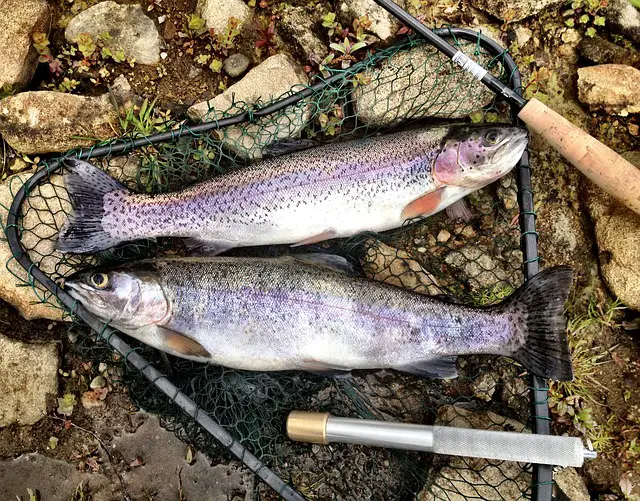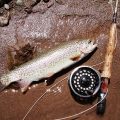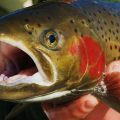
The rainbow trout is a species of salmonid that is scientifically known as Oncorhynchus
mykiss. This fish is native on the rivers and lakes in North America, and
in the cold-water rivers that drain their water into the Pacific Ocean. The
value of this fish as hard-fighting game fish along with its tastiness has been
the main reason behind its introduction to the rest of the world.
The Rainbow trout also referred to as redband trout are good-looking fish that have
coloring and patterns on their bodies that vary on the basis of their age,
spawning conditions and habitat. Generally, they are torpedo-shaped and are
either yellow-green or blue-green in color and have a pink streak on their
sides. Their underbelly is white in color and they have small black spots
distributed on their fins and their backs.
Taxonomy
As established above, the scientific name of the rainbow trout is Oncorhynchus
mykiss. This species was given this name by the German scientist known as
Johann Julius Walbaum in 1792. The specimens used by this German scientist were
from the Kamchatka Peninsula in Siberia. The name mykiss was literally derived
from the local name mykizha that the Kamchatkan people call the Rainbow trout.
The generic name, Oncorhynchus was derived from two Greek names, Onkos
(meaning “hook”) and rynchos (meaning “nose”). Several other scientists
attempted to give this type of fish their unique scientific names. For
instance, in 1836, Sir John Richardson, a naturalist based in Scotland named
the Rainbow trout Salmo gairdneri, in honor of Meredith Gairdner who had
provided him with the specimens.
Despite all the attempts made at giving this fish other scientific names, the taxonomic
authorities, in 1989, moved Pacific basin trout, cutthroat, and the Rainbow
trout into the genus Oncorhynchus. Since it was only Walbaum’s name that was
related to the generic name selected by the taxonomic authorities, this fish
continued being recognized as Oncorhynchus mykiss. All the other names
were used to identify the subspecies of this fish located in different parts of
the world.
A detailed description of their body
The resident Rainbow trout weighs between 0.5 and 2.3 Kgs in the riverine conditions. The
lake-dwelling forms of this fish weigh as much as 9 Kg. the coloration on their
bodies varies widely depending on the species and subspecies, and the
geographical location. The adult fish, during the mating season, have the most
pronounced pink lines on their sides, along the lateral lines.
Their caudal fins tend towards being square-shaped, but they are also mildly forked. The
lake-dwelling forms of this fish happen to be more silvery in color, with the
pink stripe on their sides being almost completely invisible. The young rainbow
trout usually display parr marks, which are essential dark vertical bars, on
their bodies. This is also a common feature in the salmonid juveniles. A
significant number of the juvenile trout usually retain the parr marks into
adulthood.
Feeding Rainbow trout are generally predators which depend on varied diet. They, therefore, eat
almost anything that they can capture as they move around water. They are
however not as aggressive as brown trout in capturing their prey. The juvenile,
as well as adult forms of this fish, routinely feed on aquatic insects in their
various forms of growth. The most common aquatic insects they feed on include
aquatic Diptera, stoneflies, caddisflies, and mayflies.
They have also been discovered to feed on fish eggs and the adult forms of land insects
such as ants, crickets, grasshoppers, and beetles. There are species of Rainbow
trout that feed on small fish, more so those that have a body length that does
not exceed a third of Rainbow trout’s body length. The most common type of fish
that they feed on includes crayfish and shrimp. As the Rainbow trout fish grow,
the proportion of the fish that they feed on also grows.
Some of the lake-dwelling species of the Rainbow trout end up becoming planktonic feeders.
In the streams and rivers that are highly populated with the salmonid species,
the rainbow trout mainly feed on fish eggs, and the decomposing flesh from the
carcasses of these fish. The adult Rainbow trout living in the ocean primarily
feed on squid, amphipods and other fish.
Uses of the Rainbow trout
1. Game Fishing
The Rainbow trout are highly regarded as game fish. They happen to be a popular target for
the fly fishers who use a variety of angling methods. The common technique used
includes the use of lures which are presented through casting, spinning and
trolling. Another technique is the bait method, in which live and dead baits
are used to capture the Rainbow trout.
The International Game Fish Association recognizes Sean Konrad as the person who
has in the history of game fishing caught the largest rainbow trout. On
September 5, 2009, Konrad captured a Rainbow Trout which weighed 22kg, in Lake
Diefenbaker. This specific Rainbow trout was, however, a genetically modified
hatchery escapee.
This fish is loved by anglers due to the way it has the hardest-fighting spirit amongst all
of the trout species. This fish leaps when hooked and puts up a very powerful
struggle. It is therefore ranked amongst the top five game fish in North
America. It is also the most important game fish in the geographical region that
lies to the west of the Rocky Mountains.
The Rainbow trout are highly adaptable fish. When they are relocated to other parts of the
world, they usually outcompete indigenous species of fish living in the new
ecosystem. As such, the introduction of this fish to different parts of the
world with the intention of game fishing has more often than not resulted in
the disruption of the ecosystem.
2. Food
The Rainbow trout is popular cuisine amongst the people living in the Western parts of the
world. These fish are usually obtained through purchasing from farmers and
through wild fishing. Most people love this fish due to its tender flesh, in
addition to its mild and nutty flavor. The wild Rainbow trout have a gamier
taste in comparison to the farmed fish. The taste of the wild forms of this
fish is usually promoted as superior. The farmed fish, which are the most
served in American restaurants, are usually considered very safe to eat due to
their high vitamin B content and their appealing flavor. In fact, Seafood Watch
ranks the farmed forms of the Rainbow trout as the “Best Choice” fish for
consumption by human beings.










